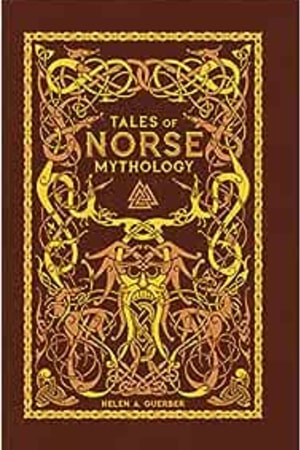Religion & Spirituality
Religious Studies
- Publisher : Barnes & Noble
- Published : 01 Jan 2017
- Pages : 0
- ISBN-10 : 1435164989
- ISBN-13 : 9781435164987
- Language : English
Tales Of Norse Mythology
Scandinavians of the Viking Age explored the mysteries of life through their sagas. Folklorist Helen Adeline Guerber brings to life the gods and goddesses, giants and dwarves, and warriors and monsters of these stories in Tales of Norse Mythology. Ranging from the comic to the tragic, these legends tell of passion, love, friendship, pride, courage, strength, loyalty, and betrayal.
Readers Top Reviews
Anthony AlfredJos
Quality Of book is excellent and information and book is very detailed.
JFDR1859Anthony A
I may expand on this at a later time. The book is aesthetically beautiful and extraordinarily well organized. I honestly want to show off the book now that it is in my collection, it is that beautiful. Overall it seems very well written but I am noticing some errors, most of which seem to be typographical in nature. This book is certainly wonderful for a layman, but I am actually using it for research and there-in lies my concern. While it is an amazing reference, there does seem to be some glaring issues that strike me as odd and I can't discern whether it is creative parabole (metaphor), accurate information or typographic. For example, on page 391, it references the 9 worlds of Niflheim and compares it to the divisions of Hades in Greek mythology. I am not aware of Niflheim containing 9 worlds but there being 9 realms of the Norse cosmos and Niflheim being one of the primordial ones (along with Muspelheim, which may not even be a place but a being or concept). The comparison to Greek mythology is sound, but that hiccup has me concerned there are more that I may miss. There is a significant amount of similarities in many of the stories that mimic not only Greek mythology, but other religious texts--the creation story for example is very similar to the Christian creation story in translations, down to specific wordage (sons of men and children of men), but this is to be expected given a lot of the resources were written by Christians and even in attempts to be neutral are subject to boughts of cognitive bias. The issue is there is many ways to interpret that poems and prose, so maybe the author came across something I have not encountered or just seemingly interprets it differently. For example, the same beings have the same names; Fenris (Fenrir) is likely the same wolf as Garm (Garmr) that is bound to Hel. Fenrir is bound to a boulder named Gjoll located in Hel, which is actually the same name of the river (Gjoll) that those must pass to enter Hel, where Garmr is also bound to. Or similarly, High, Just-as-High and Third in Gylfaginning (Prose Edda) tell the creation story and at one point reference Odin citing his names, to which Odin names all three of those names (Third, High and Just-as-High)--implying that it is in fact Odin speaking (which is plausible given Odin's ability to shape-shift, similar to Zeus in Greek mythology). Consequently, I am empathetic that there are many ways to view the same thing. I also have to take into account that this book was originally written over a century ago and may be reflective of the information known at that time. Regardless of any of this, it is a wonderful book.
Scooby Dooby...Wh
The book itself is absolutely stunning to look at, with so many hidden runes and artistic nuances which titillates the initiated eye. All the artistic additives really give to the whole experience and capture the soul of the reader. The stories are magnificent and very well put together, some of them I had never heard before. The one and only problem I have with this book is the fact that it was written by an outsider looking in, who has no deep understanding or passion for a lot of these myths. I in no way mean that as an insult, in order to understand the nuance of Norse myth it takes more than research and knowledge, I can’t expect so much from every modern author of these ancient myths. The majority of the stories I read in this book had varying degrees of missing, untrue/warped, misunderstood, and/or added information within them which I was able to decipher only because I already had a deep understanding of the myths. There were some myths which I had never seen or heard before reading this book, and Óðinn only knows whether there’s any weird misgivings in them (they may have even been made up by someone and fed to the Author, or by the Author themself). All in all this is a really fun, beautiful book and those already familiar with Norse myth should jump right in; a small warning to the uninitiated, understand that these myths might not be exactly like the originals, and could harbor misinformation. You’ve been warned!


